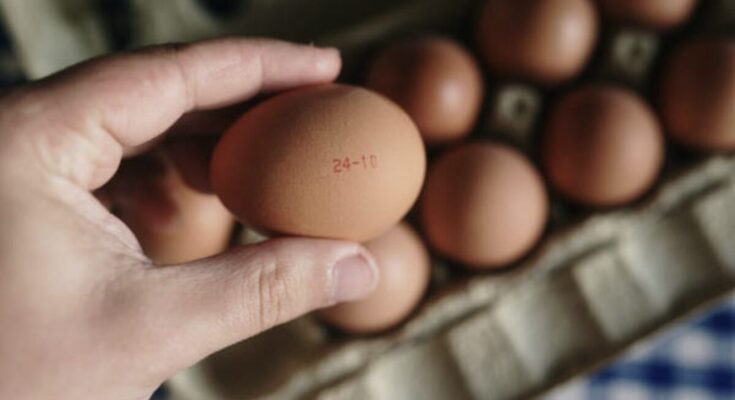For those who enjoy eggs as much as I do, there’s something oddly satisfying about cracking open that shell, whether it’s for a sunny-side-up breakfast, a fluffy omelet, or a delicious homemade cake. But beyond the joy of cooking with eggs, did you know that there’s a hidden language right on the egg carton? It’s a language that reveals when and where the eggs were packed, providing crucial information that can impact not only the freshness of your eggs but also their safety. Here’s what you need to know about decoding your egg carton to elevate your culinary skills and ensure top-notch quality with every dish.
The “Julian Date”: Your Egg’s Birthday
If you’ve ever seen a three-digit code on an egg carton and wondered what it meant, you’re not alone. Those numbers actually indicate the Julian date, a simple yet important piece of information that tells you the exact day of the year the eggs were packed. The code ranges from 001 to 365, covering January 1st through December 31st. For instance, “001” means January 1st, while “365” corresponds to December 31st.
I still remember the first time I discovered this little secret. Standing in my kitchen, carton in hand, I noticed a code like “075” and realized, “Hey, these eggs were packed on March 16th!” It felt a bit like I’d cracked a case, like Sherlock Holmes of the grocery store. Knowing this date can be an invaluable tool when you’re shopping, allowing you to select the freshest eggs possible.
The Plant Code: Where Your Eggs Come From
Besides the Julian date, you’ll often find a code starting with “P” on the carton. This is the plant code, and it indicates where the eggs were processed and packed. This information might seem trivial at first, but it can be a lifesaver in the event of an egg recall. During recalls—such as a well-known one years back due to salmonella contamination—understanding the plant code can help you quickly determine if your eggs are at risk.
This knowledge came in handy for me during a recall period when I’d just purchased a few cartons. Initially, I felt a wave of panic, wondering if the eggs I’d just brought home were safe to eat. But after checking the plant code and Julian date, I breathed a sigh of relief, knowing my eggs weren’t affected. Learning to read these codes ensures an extra layer of safety that allows you to make informed choices.
Freshness and Expiration: Eggs Have a Timeline
Eggs may be one of the more long-lasting items in your fridge, but they still have an expiration timeline. If stored correctly, eggs are typically safe for up to 30 days from their packing date. That’s where the Julian date becomes a handy tool for gauging freshness. Knowing how long your eggs have been sitting can make a noticeable difference in the quality of your dishes, from the vibrancy of the yolk to the fluffiness of an omelet.
When I come home from the store, I make it a habit to check the Julian date on the carton, and I jot down a rough “use by” date. This way, I know exactly how long I have to use them up. It’s a small habit, but it’s been incredibly helpful. In fact, I’m convinced my cooking improved just by using fresher eggs—the colors are brighter, and the flavors are noticeably richer.
Quality Marks: More Than Just Dates
Beyond the Julian date and plant code, you might notice additional marks or labels on your egg carton, such as the USDA grade shield or terms like “organic” or “pastured.” These indicators provide insight into the quality and sourcing of the eggs, helping you make the best choice for your needs.
- USDA Grade Shield: Eggs with this shield have undergone a quality inspection. Grade AA eggs, for instance, boast firm yolks and thick egg whites, ideal for frying or poaching. Grade A eggs are slightly less firm but still perfect for most recipes.
- Organic or Pastured: If you’re looking for eggs from chickens that were cage-free and fed an organic diet, these labels are your guide. Organic eggs come from chickens raised on organic feed without antibiotics, while pastured eggs come from chickens that are free to roam and forage, resulting in eggs that many people find tastier and more nutritious.
The Julian Date and Perfectly Fresh Eggs: A Game-Changer in the Kitchen
One Saturday morning, I decided to make an omelet. As I reached for the egg carton, I glanced at the Julian date and saw they were packed only a week prior. Reassured, I cracked a few eggs into a bowl and noticed their golden-orange yolks and firm whites, sure signs of freshness. The quality of these fresh eggs was unmistakable as I whisked them with a touch of milk, salt, and pepper. As I poured the mixture into a hot skillet, the eggs rose beautifully, creating an omelet that was fluffy and full of flavor.
Had I ignored the Julian date, I might have ended up using older eggs, and I doubt the results would have been the same. Freshness in eggs impacts everything, from flavor to texture, and this small attention to detail elevated my cooking.
Why This Matters: A Deeper Look into Egg Safety and Quality
Understanding these codes isn’t just a quirky skill; it’s a way to protect yourself and your family while maximizing the quality of your food. With the knowledge of the Julian date, you can ensure that the eggs you’re using are at their peak. The plant code can give you peace of mind in the face of recalls, while other labels like USDA grade and “organic” help you choose eggs that match your standards for quality.
Tips for Shopping and Storing Eggs
- Check the Codes Before Buying: Now that you know what these codes mean, look for the most recent Julian date when selecting eggs. It’s a quick way to ensure you’re taking home the freshest possible product.
- Store Eggs Properly: Keep eggs in the refrigerator at a stable, cold temperature. Avoid storing them on the fridge door, where temperatures fluctuate, to help maintain freshness.
- Use Eggs Within Their Window of Freshness: Mark a “use by” date on the carton based on the Julian date to keep track of how long they’ll stay fresh.
The Bottom Line: A Small Habit That Makes a Big Difference
Decoding the numbers on an egg carton may seem like a minor thing, but it’s a practice that ensures freshness, safety, and quality in every egg-based dish you make. Whether you’re a seasoned cook or just a breakfast enthusiast, this knowledge will serve you well, from making the fluffiest scrambled eggs to crafting decadent desserts. The next time you pick up a carton of eggs, take a moment to solve the “mystery” of the Julian date and plant code. Not only will you feel like an insider in the world of grocery shopping, but you’ll also enjoy the peace of mind that comes with knowing you’re serving only the freshest, safest eggs possible.
Happy egg-cracking!


